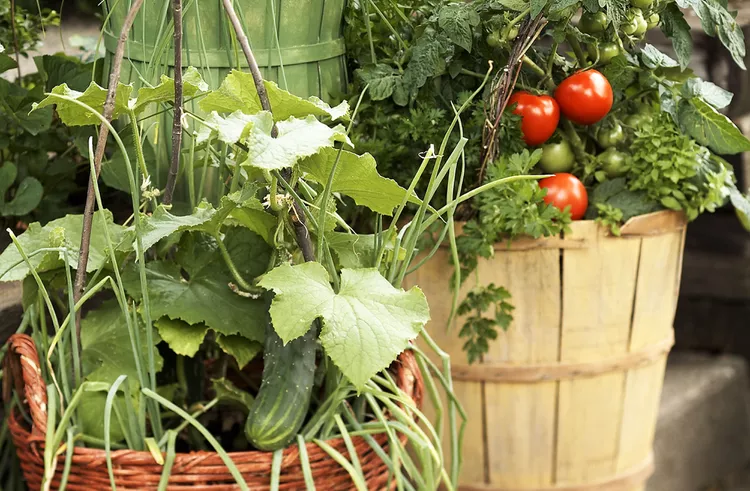Whether you grow cucumbers in pots or in a garden bed, they're among the easiest vegetables to raise. The vigorous plants will provide crunchy, refreshing cukes ranging from petite pickles to hefty slicers almost daily during harvest season. But keeping your cucumber plants healthy and productive in containers is a little different than in-ground plants. This guide includes everything you need to know to grow cucumbers in pots successfully, from thoughtful cultivar selection to the best containers to use, to must-know care tips.
Best Types of Cucumbers for Containers
Some varieties of cucumber plants produce vines that are more than 10 feet long, which isn't always ideal for container gardening. Long vines are challenging to corral in the small space of a container garden, even with a substantial trellis. Instead, choose a variety that includes “bush” or “compact” in the name. ‘Bush Slicer’ has 3-foot-long vines and 6- to 8-inch-long slicing fruit. ‘Picklebush’ and ‘Bush Champion’ are two other excellent varieties for containers.
Container-friendly cucumber varieties are most often slicing or pickling fruit types. Long, skinny English and Asian cucumbers are usually not available in compact cultivars, but that doesn’t mean you can’t grow these delicious and productive plants in a container. You’ll need an extra-large container—one that is at least 24 inches wide and deep is best. The large container provides ample root space and anchors the trellis needed to support the long vines.
Pot and Soil Pointers
Cucumber plants grow rapidly, producing several pounds of fruit in a season. All that growth requires plenty of high-quality soil. Container-grown cucumber plants thrive in pots that are at least 12 inches in diameter and hold 2 gallons or more of soil. Any large container with ample drainage holes in the bottom will work. Repurpose a found object, adding drainage holes as necessary, or use a standard planting pot.
Potting soil is best for growing cucumber plants in containers. Avoid bagged topsoil or regular garden soil; both soil types are too dense and don’t drain adequately. All-purpose potting soil is lightweight, easy to find, and simple to work with.
Steps for Planting Cucumbers in Pots
Plant cucumbers in pots once the weather is stable and night temperatures are consistently above 55°F. To start with seeds, follow these steps:
- Fill the container with potting soil to within 1 inch of the pot rim. Tamp the potting soil lightly to eliminate large air pockets.
- Sow three or four seeds 1 inch deep and 2 inches apart in the center of the container. If the container is 12 inches wide, sow just one group of seeds. If the container is 18 inches wide, sow two groups of seeds a few inches apart near the center of the container.
- Water the pot well and place it in a sunny spot.
- When the seedlings are 3 inches tall, remove all but the most robust plant in each group. It might feel ruthless to pluck out extra seedlings, but more than one cucumber plant per 18-inch-wide container will inhibit the growth of all plants and invite disease.
If you want to start with transplants from a garden center, simply repot the seedling into the large container you'd like to use. Make sure to set the plant at the same soil level as it was in its original pot. Then water it well.
Spread a 2-inch-thick layer of shredded bark mulch or pine straw over the surface of the potting soil to preserve moisture for the shallow-rooted cucumber plants.
Consider a Trellis
Don’t hesitate to add a trellis to a container at planting time. A sturdy trellis can increase fruit set even on bush or compact varieties. And traditional varieties require a climbing structure when planted in a container to keep them manageable. Sink a premade 6- to 8-foot-tall trellis deep into the soil at planting time. Or you can make your own trellis using bamboo poles and garden twine. Anchor the trellis well by plunging it a foot or more into the planting pot. As the plants grow, help vines scramble up by wrapping their tendrils around the structure as needed.
Care Tips for Cucumbers in Pots
- Water daily: Aim to keep the potting soil moist but not wet. Regular watering leads to the best flavor. Inconsistent water puts plants under stress, creating bitter cucumbers.
- Provide regular fertilizer: It takes a lot of nutrients to fuel a cucumber plant's rapid growth so use a balanced liquid fertilizer once a month when you water.
- Go on pest patrol: Monitor plants for signs of pests and disease and act if necessary. The cucumber beetle is a common pest that can ruin your harvest.
- Harvest consistently: Cucumbers are ready to harvest seven or eight weeks after planting. Harvest pickling varieties when the fruit is 2 to 4 inches long. Pick slicing cucumbers when they are 6 to 8 inches long. Picking the fruit spurs the plant to produce new flower buds and fruit. Leaving fruit on the plant signals it to stop producing.




















